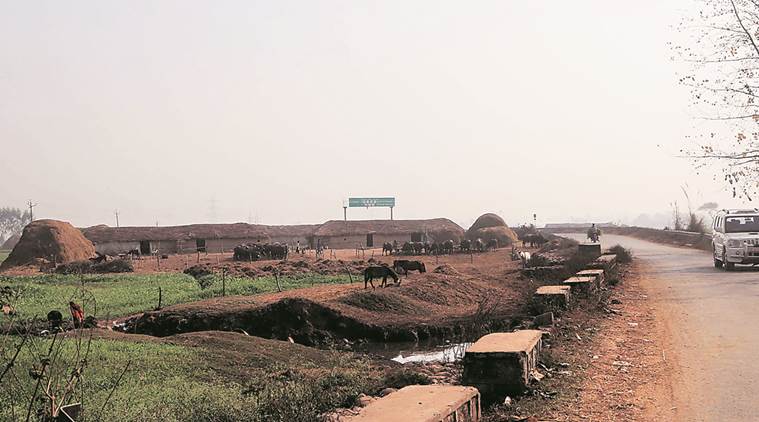Stay updated with the latest - Click here to follow us on Instagram
Pathankot and after: Year on, many questions, few answers
According to the NIA chargesheet filed in a special court in Mohali on December 19: “[The four terrorists] illegally crossed the Indo-Pak international border through the forest area near the Simbal Border Outpost."
 IMAGINE A widely scrawled W turned to face right. That is what the line on the India-Pakistan border looks like at this spot. Here is where, over the W, River Ujh enters Indian territory and exits back into Pakistan, turning off to meander further south-west to meet up with River Ravi. The sugarcane fields and the wheat crop give off a lush green lustre at this time. But, this is no rural idyll. It was through this part of the border that four terrorists from Pakistan entered India to mount an attack on the Pathankot Air Force base, exactly a year ago.
IMAGINE A widely scrawled W turned to face right. That is what the line on the India-Pakistan border looks like at this spot. Here is where, over the W, River Ujh enters Indian territory and exits back into Pakistan, turning off to meander further south-west to meet up with River Ravi. The sugarcane fields and the wheat crop give off a lush green lustre at this time. But, this is no rural idyll. It was through this part of the border that four terrorists from Pakistan entered India to mount an attack on the Pathankot Air Force base, exactly a year ago.
Watch What Else Is Making News:
A year after the attack, which claimed the lives of seven security personnel at the base and a local taxi driver whose vehicle was hijacked, and two weeks after the National Investigation Agency (NIA) filed a chargesheet in the case, locals say many questions about the infiltration still remain unanswered.
According to the NIA chargesheet filed in a special court in Mohali on December 19: “[The four terrorists] illegally crossed the Indo-Pak international border through the forest area near the Simbal Border Outpost. Empty food packets manufactured in Pakistan and other food articles from Pakistan were recovered from the forest area near the Simbal Border Outpost during investigation.”
Google Maps, used by the terrorists to spot the airbase, shows a thick patch of forest on either side of the border near Simbal. But, the locals still want to know which was the exact point of entry and how the four went undetected despite the heavy BSF presence.
The BSF has maintained that wires along the border fence were intact. The only gap is on the river, which is almost dry at this time of the year. The BSF has now put up a new check post in the middle of Ujh, in addition to the existing ones on either bank. The posts guard the break in fencing on the river and are equipped with tall searchlight towers to keep a lookout.
Though locals continue to believe that terrorists must have used the riverbed to enter, they ask how the BSF, with their powerful searchlights, failed to detect the entry.
Sumit Singh, a panchayat member of nearby Bamiyal village, owns land just a few hundred metres from the point where Ujh enters Pakistan. He has tall sugarcane crops growing on one side of the river and last year, too, the crop was as dense as it is now with the seasonal Khooni Nullah, flowing through the fields. Originating from Jammu and Kashmir, it empties into Ujh.
“The search parties of the BSF and police and later, the NIA investigators were of the opinion that the terrorists may have hid in the sugarcane fields for some time,” says Sumit, expressing surprise at how they went unnoticed despite the presence of two border observation posts in the area.
A few hundred metres from Sumit’s fields and further up the Khooni Nullah lies the tubewell of Subedar Major (Retired) Narain Singh, who noticed footmarks of terrorists in front of his tubewell on January 1. They may have crossed his field before making their way into India.
And the trail began from the nullah. There are also questions about how the four men reached the point on the Bamiyal Road where the chargesheet says they first hijacked an Innova taxi, belonging to Bhagwal resident Ikagarh Singh, whom they later killed. “They must have had someone who helped them get to the Kathana T-point from where they hijacked the Innova,” says the retired subedar major, who belonged to the Dogra Regiment.
The police had also questioned members of a Gujjar settlement next to Narain’s field and ruled out their involvement.
Kathana T-point is about 9 kms from his tubewell by road and takes around 19 minutes to reach by car via the narrow village road. Even if the terrorists were carrying heavy gear, a moderately fit person would not take more than a couple of hours to reach the place.
“Since the Army normally carries out its exercises in this area and also due to BSF presence, it is not uncommon to see people in camouflaged uniform and it would not raise suspicion,” says Narain Singh.
Echoing the same, Suresh Sharma, nambardar of Simbal village located about half-a-kilometre from the border, said, “No one would question people going about in Army uniform and though the perception is that they crossed over to Bamiyal through the fields, even if they had used the road, it would not have arisen suspicion.”
His friend Dharampal Sharma says it is a general perception that the terrorists crossed over from this part of the border. “Who can say it for sure? But then there has to be some involvement of people this side of the border, too, for them to reach so deep inside.”
The wide open fields are interspersed with bunkers and pill boxes built as defensive installations for the Army which remain unoccupied for most part of the year. At some places near Bamiyal, Simbal and Khojki Chak villages, these pill boxes are right next to the road and if someone were to occupy them, they would not be noticed even in daylight.
The T-point where Ikagar Singh was hijacked is barely one-and-a-half kilometres from where his body was eventually found just before the Kathlor bridge over River Ravi. The then Gurdaspur SP, Salwinder Singh, was also stopped at this very point by the terrorists.
The route from Simbal to Kathlor bridge now has three checkposts in addition to the one right on the bridge. This post was passed by the terrorists in SP Salwinder Singh’s SUV without being intercepted but now every vehicle coming from the border is being checked.
However, even now, there is not much checking at other checkposts leading to the border villages. Though policemen are deployed there, vehicles pass through unchecked. The border is also not sparsely populated and there is a village or some houses at every short distance from the point where the terrorists entered India to the point where they hijacked vehicles.
A year after the attack, many residents of this sensitive border area feel that the circumstances under which the terrorists entered India and managed to reach Pathankot are still not clear despite the probe carried out by the NIA.







